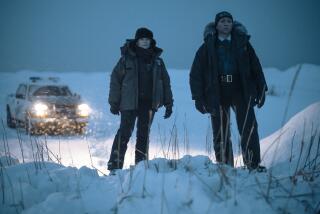Ghosts haunt all corners of television
There have been ghosts on television since there was television: “Ghost” was the word for the faintly doubled image that was common back when pictures were beamed straight to your set over the air. (Through walls — like a ghost!) And though modern technologies guarantee that current and future generations of viewers will live free from that small terror, spirits have continued to haunt the vast wasteland, both in fictional series such as “American Horror Story” and “nonfictional” series like “Ghost Hunters” and its abundant ilk, wherein variations on a team vet strange noises, weird lights and restless furniture for supernatural influence.
Some ghosts, as seen on TV, are indistinguishable from angels, specifically of the guardian variety; others are basically demons not yet living full time in hell (or, as in the late “Reaper,” who have made their way back from it). They prompt the living to be good or tempt them to be bad. They are deadly threats or harmless busybodies, pests or pals, unhappy roommates who never asked you to move in in the first place or great roommates who will help you with your love life or problem at work.
Some will help you solve an unsolved murder — as in “Haunted” or “Raines” or “Medium” or “Tru Calling,” with characters played by Matthew Fox, Jeff Goldblum, Patrica Arquette and Eliza Dushku, respectively, collaborating with the passed-on-but-not-over in the name of criminal justice — or ask for help accepting their own sudden death, if you are Jennifer Love Hewitt in “The Ghost Whisperer” or Ellen Muth in “Dead Like Me.” But every cold case, even of the nonsupernatural sort, is a ghost story, and every police procedural is haunted by the souls of the prematurely departed.
In the early days of television, ghosts were most likely to be friendly spirits, like the madcap Kerbys (and their martini-drinking Saint Bernard) who cheerfully rattled the peace of the staid hero of the mid-’50s sitcom “Topper” — a forerunner of such 1960s series as “My Favorite Martian,” “Bewitched” and “I Dream of Jeannie,” in which uncanny beings kept house with ordinary mortals. In “The Smothers Brothers Show,” from 1965, ghost brother Tommy (in “apprentice angel” mode) attached himself to living brother Dick; in “The Ghost and Mrs. Muir” (1968-70), the shade of a 19th century sea captain shared his house with a 20th century mom.
My own first ghost, as he has been for so many, was “the friendliest ghost you know”: Casper, whose afterlife was after-lived in theatrical shorts, comic books and on television. (“Casper the Friendly Ghost: The Complete Collection 1945-1963” was released on DVD this month by Shout Factory.) “Wherever he may go,” ran his theme, “he’s kind to every living creature.” That Casper is, by the traditional terms of ghostliness, a dead child is never discussed, nor would you want it to be. He had trouble enough convincing potential playmates that he was good company.
This was not the case with the less friendly spirits who followed, dealing out incorporeal punishment in the 1980s and ‘90s in anthology series like “Tales from the Darkside” and “Tales from the Crypt,” which reflected an explosion of horror on the big screen. (In the 1982 movie “Poltergeist,” produced and co-written by Steven Spielberg, whose first directing job had been on Rod Serling’s “Night Gallery,” the spooks make themselves felt through a static-filled TV screen.) They have made their way into modern serial anthologies like “Buffy the Vampire Slayer” and “Supernatural”; there are ghost characters in “The Vampire Diaries” and “Being Human.”
They also inhabit nonsupernatural dramas such as “Rescue Me” and “Six Feet Under,” where their status as “real” or hallucinations is dramatically beside the point; they are there to turn monologues into conversation and to represent conscience. “Northern Exposure” was always a friendly place for ghosts, to similar though funnier purpose. And on this season’s “A Gifted Man,” in which the saintly, spectral ex-wife of a doctor moves his worldly mind to good deeds, the ghost (I think) is real, but her job remains the same.
But nowhere do the deceased live so successfully as on the ghost-hunting reality shows, too many to name here, that have colonized basic cable. Perhaps only the home makeover has proved as variable and tenacious a genre, and in a way the two are related, the undead being a well-known drag on property values. (Still, as on “American Horror Story,” there is always some chump happy to take the discount.) These series take ghosts as a given and are no more “skeptical” than is necessary to look “scientific.” The judgments of their investigators range from the hopefully noncommittal (Just because we haven’t proved a ghost did this doesn’t mean a ghost didn’t) to the irrefutably personal (I definitely felt something there).
However you regard their substance, as metaphors they are always hanging about, right over your shoulder, the most ordinary sort of monsters. Ghosts were people too and in most respects remain so. We’re all haunted, occasionally or chronically, by our own past — and by our own remembered dead — which we reciprocally haunt, as powerless as ghosts to change what happened there. And who hasn’t heard something go bump in the night or seen someone who wasn’t there, in the wee hours, out of the corner of an eye — however we like to explain it? Or not.
More to Read
The complete guide to home viewing
Get Screen Gab for everything about the TV shows and streaming movies everyone’s talking about.
You may occasionally receive promotional content from the Los Angeles Times.







